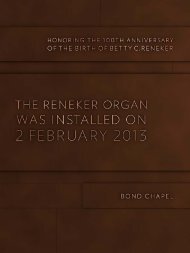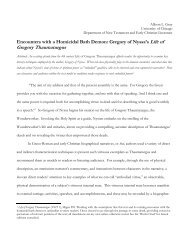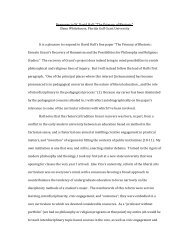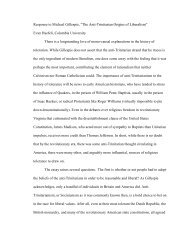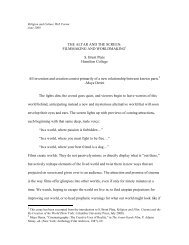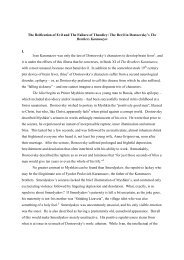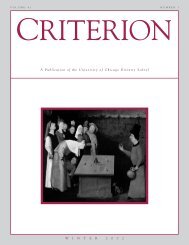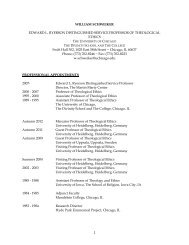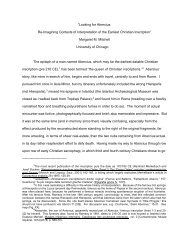Housing the Dead: the tomb as house in Roman Italy - Divinity School
Housing the Dead: the tomb as house in Roman Italy - Divinity School
Housing the Dead: the tomb as house in Roman Italy - Divinity School
Create successful ePaper yourself
Turn your PDF publications into a flip-book with our unique Google optimized e-Paper software.
image of <strong>the</strong> atrium w<strong>as</strong> <strong>the</strong> <strong>in</strong>wards slop<strong>in</strong>g roof and impluvium, were <strong>the</strong> <strong>tomb</strong>s with <strong>the</strong>ir<br />
outwards-slop<strong>in</strong>g roofs really evok<strong>in</strong>g atria?<br />
10<br />
To be honest, short of substantial new evidence about early hous<strong>in</strong>g <strong>in</strong> both Rome and Etruria, this<br />
debate is liable to loop <strong>in</strong> circles. But for present purposes, it is enough to observe that Etruscan<br />
<strong>tomb</strong>s persistently had features that evoke a domestic context, like chairs, couches and pillows,<br />
taken to a height <strong>in</strong> <strong>the</strong> fourth-century Tomba dei Rilievi at Cerveteri, <strong>in</strong> which <strong>the</strong> pl<strong>as</strong>tered walls<br />
are decorated by a splendid range of furnish<strong>in</strong>gs which are at le<strong>as</strong>t partly domestic (though also<br />
partly ritual, po<strong>in</strong>t<strong>in</strong>g to sacrifice). But where <strong>the</strong> domestic imagery ga<strong>in</strong>s its relevance is <strong>in</strong> <strong>the</strong><br />
function of such <strong>tomb</strong>s <strong>in</strong> reconstitut<strong>in</strong>g and represent<strong>in</strong>g <strong>the</strong> family. The architecture <strong>in</strong> itself, by<br />
creat<strong>in</strong>g a series of beds, arranged with a strong sense of hierarchy, <strong>the</strong> preferred position be<strong>in</strong>g <strong>the</strong><br />
central niche of <strong>the</strong> ‘tabl<strong>in</strong>um’, and possibilities of subgroup<strong>in</strong>gs <strong>in</strong> <strong>the</strong> lateral chambers, po<strong>in</strong>ts to<br />
<strong>the</strong> desire to represent <strong>the</strong> occupants <strong>as</strong> a structured group. The abundant epigraphic material<br />
confirms that <strong>the</strong> typical group w<strong>as</strong> <strong>the</strong> multigenerational family.<br />
A cl<strong>as</strong>sic example, from a period of close <strong>in</strong>teraction with <strong>the</strong> middle Republican <strong>Roman</strong><br />
aristocracy, is <strong>the</strong> <strong>tomb</strong> of <strong>the</strong> Volumnii at Perugia (e.g. Haynes 2000, 379ff). Dat<strong>in</strong>g from <strong>the</strong> late<br />
third century, <strong>the</strong> <strong>tomb</strong> is located outside <strong>the</strong> town at <strong>the</strong> bottom of <strong>the</strong> hill. Externally it is<br />
unremarkable: steps lead down to an underground chamber hewn from <strong>the</strong> soft sandstone. At <strong>the</strong><br />
bottom is a large rectangular hall (‘atrium’) with a pitched roof and rafters, with a ma<strong>in</strong> chamber<br />
(‘tabl<strong>in</strong>um’) on <strong>the</strong> central axis, and two lateral chambers (Fig. 8). The ma<strong>in</strong> chamber conta<strong>in</strong>s <strong>the</strong><br />
rema<strong>in</strong>s of seven named members of <strong>the</strong> Volumnius/Velimna family. Arnth Velimn<strong>as</strong>, <strong>the</strong> founder<br />
of <strong>the</strong> <strong>tomb</strong>, dom<strong>in</strong>ates from his high couch with pillows and drapes, held aloft by two w<strong>in</strong>ged<br />
daemons(Fig. 9). To <strong>the</strong> left, his daughter Veilia Velimnei is <strong>the</strong> one female of <strong>the</strong> group, <strong>the</strong><br />
unmarried daughter of Arnth. Male descendants (Thefri, Avle, Larth and Vel) stretch down to <strong>the</strong><br />
l<strong>as</strong>t, early imperial, member of <strong>the</strong> group, Publius Volumnius Violens, <strong>Roman</strong> enough to Lat<strong>in</strong>ise<br />
his script and name, but still Etruscan enough to give his matronym. His elegantly carved <strong>as</strong>h urn is<br />
<strong>in</strong> <strong>the</strong> form of a rectangular build<strong>in</strong>g with a pitched and tiled roof, double doors and Cor<strong>in</strong>thian<br />
pil<strong>as</strong>ters; a <strong>house</strong>, it is normally said, though <strong>the</strong> form is a great deal closer to a temple than a <strong>house</strong><br />
(Fig.10).<br />
I l<strong>in</strong>ger over this Etruscan background <strong>in</strong> order to br<strong>in</strong>g out a po<strong>in</strong>t relevant to <strong>the</strong> issue of <strong>the</strong><br />
<strong>in</strong>ternal/external functions of <strong>the</strong> <strong>tomb</strong>. Despite <strong>the</strong> appearance of ‘streets of <strong>tomb</strong>s’ from <strong>the</strong> sixth<br />
century, <strong>the</strong> <strong>tomb</strong>s of <strong>the</strong> cl<strong>as</strong>sical Etruscan tradition have a relatively m<strong>in</strong>or engagement with <strong>the</strong>



